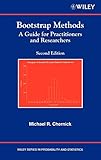Bootstrap methods : a guide for practitioners and researchers / Michael R. Chernick
Tipo de material: TextoSeries Wiley series in probability and statisticsEditor: Hoboken, N.J. : Wiley-Interscience, 2008Edición: Second editionDescripción: xviii, 369 páginas : ilustracionesTipo de contenido: texto Tipo de medio: no mediado Tipo de portador: volumenISBN: 9780471756217 (cloth); 0471756210 (cloth)Tema(s): BOOTSTRAP (Estadística)Clasificación CDD: 519.544 Recursos en línea: VERSIÓN DIGITAL
TextoSeries Wiley series in probability and statisticsEditor: Hoboken, N.J. : Wiley-Interscience, 2008Edición: Second editionDescripción: xviii, 369 páginas : ilustracionesTipo de contenido: texto Tipo de medio: no mediado Tipo de portador: volumenISBN: 9780471756217 (cloth); 0471756210 (cloth)Tema(s): BOOTSTRAP (Estadística)Clasificación CDD: 519.544 Recursos en línea: VERSIÓN DIGITAL | Tipo de ítem | Biblioteca actual | Colección | número de clasificación | Copia número | Estado | Notas | Fecha de vencimiento | Código de barras |
|---|---|---|---|---|---|---|---|---|
 Bibliografía General Complementaria
Bibliografía General Complementaria
|
Biblioteca Campus San Joaquín | Colección General | 519.544 C521 (Navegar estantería(Abre debajo)) | 1 | Disponible | 35609002082549 | ||
 Bibliografía General Complementaria
Bibliografía General Complementaria
|
Biblioteca Central | Colección General | 519.544 C521 (Navegar estantería(Abre debajo)) | 1 | Disponible | 3560900255761 |
Navegando Biblioteca Campus San Joaquín Estantes, Ubicación: Colección General, Código de colección: Colección General Cerrar el navegador de estanterías (Oculta el navegador de estanterías)

|

|

|

|

|

|

|
||
| 519.542 L744 Bayesian probability theory : applications in the physical sciences / | 519.542 L744 Bayesian probability theory : applications in the physical sciences / | 519.542 L744 Bayesian probability theory : applications in the physical sciences / | 519.544 C521 Bootstrap methods : a guide for practitioners and researchers / | 519.6 R892 2021 An optimization primer / | 519.7 F775 AMPL : | 519.76 B551 Nonlinear programming / |
1. What is bootstrapping? -- 1.1. Background -- 1.2. Introduction -- 1.3. Wide range of applications -- 1.4. Historical notes -- 1.5. Summary -- 2. Estimation -- 2.1. Estimating bias -- 2.1.1. How to do it by bootstrapping -- 2.1.2. Error rate estimation in discrimination -- 2.1.3. Error rate estimation: an illustrative problem -- 2.1.4. Efron's patch data example -- 2.2. Estimating location and dispersion -- 2.2.1. Means and medians -- 2.2.2. Standard errors and quartiles -- 2.3. Historical notes -- 3. Confidence sets and hypothesis testing -- 3.1. Confidence sets -- 3.1.1. Typical value theorems for M-estimates -- 3.1.2. Percentile method -- 3.1.3. Bias Correction and the Acceleration Constant -- 3.1.4. Iterated Bootstrap -- 3.1.5. Bootstrap Percentile t Confidence Intervals -- 3.2. Relationship Between Confidence Intervals and Tests of Hypotheses -- 3.3. Hypothesis Testing Problems -- 3.3.1. Tendril DX Lead Clinical Trial Analysis -- 3.4. Application of bootstrap confidence Intervals to Binary Dose-Response Modeling -- 3.5. Historical Notes -- 4. Regression analysis -- 4.1. Linear Models -- 4.1.1. Gauss-Markov Theory -- 4.1.2. Why Not Just Use Least Squares? -- 4.1.3. Should I Bootstrap the Residuals from the Fit? -- 4.2. Nonlinear Models -- 4.2.1. Examples of Nonlinear Models -- 4.2.2. Quasi-optical Experiment -- 4.3. Nonparametric Models -- 4.4. Historical Notes -- 5. Forecasting and Time Series Analysis -- 5.1. Methods of Forecasting -- 5.2. Time Series Models -- 5.3. When Does Bootstrapping Help with Prediction Intervals? -- 5.4. Model-Based Versus Block Resampling -- 5.5. Explosive Autoregressive Processes -- 5.6. Bootstrapping-Stationary Arma Models -- 5.7. Frequency-Based Approaches -- 5.8. Sieve Bootstrap -- 5.9. Historical notes -- 6. Which resampling Method Should You Use? -- 6.1. Related Methods -- 6.1.1. Jackknife -- 6.1.2. Delta Method, Infinitesimal Jackknife, and Influence Functions -- 6.1.3. Cross-Validation -- 6.1.4. Subsampling -- 6.2. Bootstrap variants -- 6.2.1. Bayesian bootstrap -- 6.2.2. Smoothed bootstrap -- 6.2.3. Parametric Bootstrap -- 6.2.4. Double bootstrap -- 6.2.5. m-out-of-n Bootstrap -- 7. Efficient and Effective Simulation -- 7.1. How Many Replications? -- 7.2. Variance Reduction Methods -- 7.2.1. Linear Approximation -- 7.2.2. Balanced Resampling -- 7.2.3. Antithetic Variates -- 7.2.4. Importance Sampling -- 7.2.5. Centering -- 7.3. When Can Monte Carlo Be Avoided? -- 7.4. Historical Notes -- 8. Special Topics -- 8.1. Spatial Data -- 8.1.1. Kriging -- 8.1.2. Block Bootstrap on Regular Grids -- 8.1.3. Block Bootstrap on Irregular Grids -- 8.2. Subset Selection -- 8.3. Determining the Number of Distributions in a Mixture Model -- 8.4. Censored Data -- 8.5. p-Value Adjustment -- 8.5.1. Description of Westfall-Young Approach -- 8.5.2. Passive Plus OX Example -- 8.5.3. Consulting Example -- 8.6. Bioequivalence Applications -- 8.6.1. Individual Bioequivalence -- 8.6.2. Population Bioequivalence -- 8.7. Process Capability Indices -- 8.8. Missing Data -- 8.9. Point Processes -- 8.10. Lattice Variables -- 8.11. Historical Notes -- 9. When Bootstrapping Fails Along with Remedies for Failures -- 9.1. Too Small of a Sample Size -- 9.2. Distributions with Infinite Moments -- 9.2.1. Introduction -- 9.2.2. Example of Inconsistency -- 9.2.3. Remedies -- 9.3. Estimating Extreme Values -- 9.3.1. Introduction -- 9.3.2. Example of Inconsistency -- 9.3.3. Remedies -- 9.4. Survey Sampling -- 9.4.1. Introduction -- 9.4.2. Example of Inconsistency -- 9.4.3. Remedies -- 9.5. Data Sequences that Are M-Dependent -- 9.5.1. Introduction -- 9.5.2. Example of Inconsistency When Independence Is Assumed -- 9.5.3. Remedies -- 9.6. Unstable Autoregressive Processes -- 9.6.1. Introduction -- 9.6.2. Example of Inconsistency -- 9.6.3. Remedies -- 9.7. Long-Range Dependence -- 9.7.1. Introduction -- 9.7.2. Example of Inconsistency -- 9.7.3. Remedies -- 9.8. Bootstrap Diagnostics -- 9.9. Historical Notes.
INF-280 (Ingeniería Civil Informática)
Última actualización 28 de septiembre 2023

